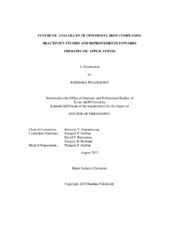| dc.description.abstract | Dinitrosyl iron complexes (DNICs) are organometallic-like compounds formed endogenously as products of degradation of iron-sulfur clusters by NO or its interaction with the cellular chelatable iron pool. Substantial evidence has accrued on the role of DNICs as endogenous transport and storage agents for the highly reactive NO radical. Such biological significance has led to biomimetic work on such entities in synthetic inorganic chemistry. Recently, such synthetic models have emerged as a new class of potential NO releasing agents. A series of N-heterocyclic carbene (NHC)-stabilized oxidized and reduced DNICs ({Fe(NO)2}^9 /{Fe(NO)2}^10: Enemark-Feltham notation) appeared promising candidates for further investigations on the reactivity of DNICs and on synthetic improvements for possible therapeutic applications.
Planar NHC ligands mimic ligands such as imidazole, itself a surrogate for histidine. A base-promoted conversion was observed of an N-alkyl imidazole bearing, neutral {Fe(NO)2}^10 DNIC to the NHC-DNIC, while maintaining the Fe(NO)2 unit intact. Subsequent alkylation led to the isolation of the NHC-DNIC product; signifying the integrity of the Fe(NO)^2 unit and further establishing that NHCs are ‘better’ ligands to Fe(NO)2 than imidazoles.
Making use of an NHC-stabilized DNIC [(NHC)(RS)Fe(NO)2], a RS^−/RS• oxidation process in the presence of added CO was discovered, wherein the oxidized {Fe(NO)2}^9 is reduced to {Fe(NO)2}^10 through carbon monoxide (CO)/RS• ligand substitution. Kinetic studies established a bimolecular rate law and activation parameters suggested an associative mechanism. Computational results indicated a unique role for the delocalized frontier molecular orbitals of the Fe(NO)2 unit, involving an initial side-on approach of CO to the electron-rich N-Fe-N site.
Attempts to further test the aforementioned computational proposal employed classical Hammett correlations for the elucidation of structure-activity relationships. Hammett correlations were used to monitor the changes in electron density at the {Fe(NO)2} unit and effects on the rate of reaction with CO of a series of (NHC)(SPhX)Fe(NO)2 derivatives with varying para substituents at the aryl thiolate. In accordance with the computational mechanistic proposal, rate enhancement was observed with increasing electron donating ability of the substituents.
Although DNICs appear to be promising candidates in the context of nitric oxide releasing therapeutics, their lack of biocompatibility has hindered the progress of such applicability. The first examples of ‘sugar appended’ monomeric and dimeric DNICs were synthesized, making use of the tuning sites provided by the NHC-DNIC architecture. Such efforts are among the few examples for the synthesis of bio-functionalized DNICs. | en |


